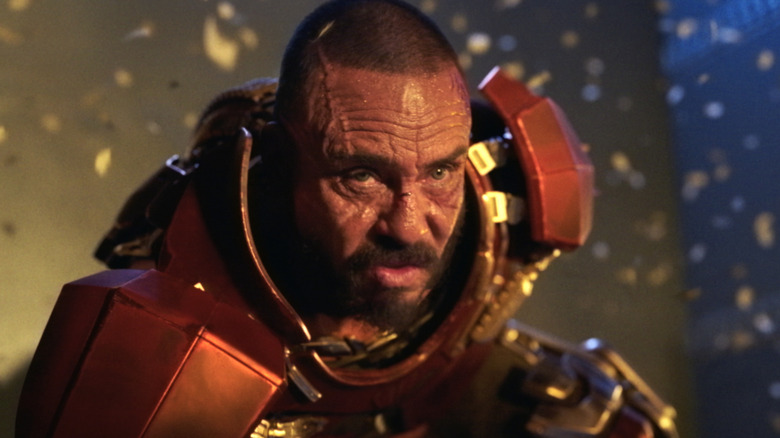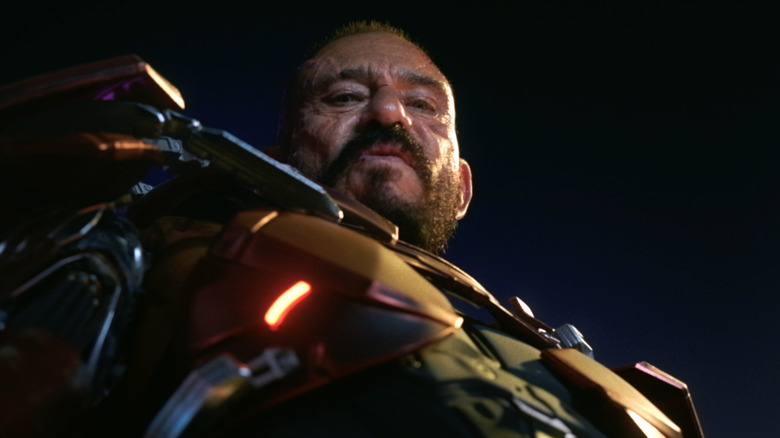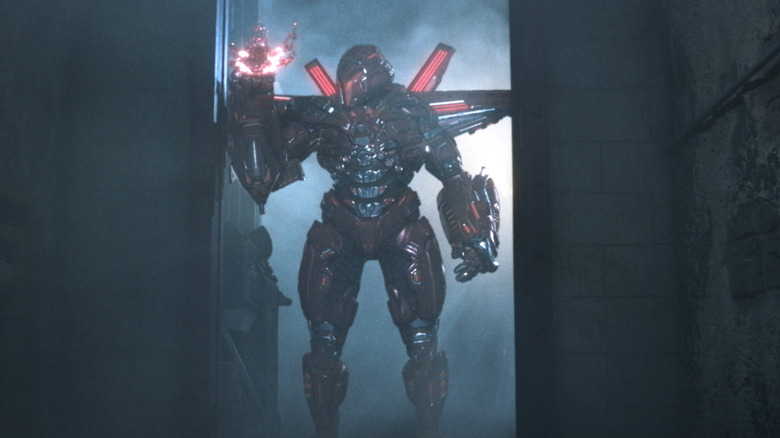Blue Beetle Could Ruin DC's New Movie Universe Before It Begins
There are plenty of Easter eggs and small details in "Blue Beetle" for comic book obsessives to look out for and speculate about. The film, which features the live-action DC Universe debut of Jaime Reyes (Xolo Maridueña), is more of a stand-alone superhero origin story than it is a slice of lore-heavy franchise worldbuilding. That doesn't mean, however, that "Blue Beetle" doesn't plant the seeds for future DCU storylines, characters, and conflicts. On the contrary, one of the film's main villains, Victoria Kord (Susan Sarandon), introduces a comic book invention that could very well come back to haunt every superhero in the DCU.
Early in "Blue Beetle," it's revealed that Victoria intends to use the Scarab to power her One Man Army Corps (OMAC) project and create a global police force of superpowered android soldiers that answer to her. The film's secondary villain, Ignacio Carapax (Raoul Max Trujillo), already has a prototype version of Victoria's OMAC armor fused to his body by the time he's introduced in "Blue Beetle." Later, in the movie's third act, Victoria not only succeeds at upgrading Ignacio's armor using the Scarab's alien code but also uploads its data into the hundreds of other OMAC devices hidden within her island compound.
Thankfully, Victoria's niece, Jenny (Bruna Marquezine), and Jaime's sister, Milagro (Belissa Escobedo), seemingly destroy all of her OMAC devices before she gets the chance to use or distribute them. That said, there's still a chance Victoria's OMAC technology could be brought back at some point in the future. James Gunn, the co-architect of Warner Bros.' new DC Universe, could, in fact, create a massive conflict by introducing a variant version of the OMACs featured in "Blue Beetle."
There have been multiple kinds of OMACs over the years
The original comic book version of OMAC is a man named Buddy Blank, whose connection to an A.I. satellite known as "Brother Eye" imbues him with superhuman powers. Introduced in the early 1970s, Blank never became much of a prominent DC Comics figure. His superhero name, however, became a well-known moniker among comic book readers when OMAC was rebranded in 2005 from "One Man Army Corps" to "Observational Metahuman Activity Construct" and later "Omni Mind And Community."
With the rebranding came another change: Buddy Blank was no longer the world's only OMAC. Instead, it was revealed that there are over 1 million genetically altered cyborg OMACs living on Earth. These OMACs are controlled by the Brother MK I satellite, which had been created by Batman and — in a nod to comic book history — a scientist named Buddy Blank. The satellite was designed to gather data on all of the world's metahumans, but it is given sentience by none other than Alexander Luthor Jr., which paves the way for the villainous Maxwell Lord to instill a fear in Brother MK I's programming toward the very metahumans it is collecting intel on.
When Lord is later killed by Wonder Woman, Brother MK I initiates a secret protocol known as "KingIsDead" and renames itself "Brother Eye." The protocol commands all of the world's OMACs to find and kill every metahuman on Earth. Only through the combined efforts of multiple superheroes, including Jaime Reyes' Blue Beetle, are the Brother Eye satellite's plans derailed. With all this in mind, it seems safe to say that James Gunn could somewhat easily reconfigure the OMAC lore introduced in "Blue Beetle" to fit a Brother Eye-inspired narrative in the DCU.
Blue Beetle leaves the door open for a future OMAC story
At the end of "Blue Beetle," Victoria Kord is seemingly dead, and so are all of her OMAC dreams. However, it wouldn't take much for the DCU's creative team to convince audiences that Victoria's OMAC designs and plans somehow survive her death and the destruction of her island compound. A twist like that, combined with the creation of more OMAC devices like the ones seen in the last act of "Blue Beetle," could easily set up the introduction of an army of technologically advanced soldiers like Raoul Max Trujillo's Ignacio Carapax.
In other words, all a future DCU movie would have to do in order to finish setting up a global OMAC attack storyline — like the one that's already been done in the comics — is introduce a Brother Eye-esque satellite. Frankly, that doesn't seem all that difficult, or out of the realm of possibility. Considering how many superheroes "Blue Beetle" references, as well as how many are set to be featured in 2025's "Superman: Legacy," it seems safe to say that the DC Universe already contains more than its fair share of metahumans too.
A metahuman-targeted OMAC attack, therefore, seems like an obvious storyline for a future DCU crossover title to explore. Of course, whether or not that actually ends up happening remains to be seen. Either way, while "Blue Beetle" is more self-contained than some fans may have expected, it's worth noting that it still introduces several concepts that could very well be used to the DCU's dramatic benefit in the future.


